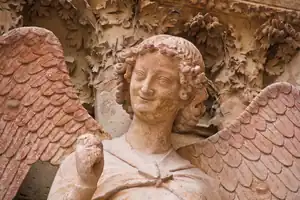Smiling Angel
The Smiling Angel (French: L'Ange au Sourire), also known as the Smile of Reims (Le Sourire de Reims) or Angel of the Annunciation, is a stone sculpture at the cathedral of Reims. Sculptors that were pioneers of the Gothic style came from workshops in Chartres, Paris and Amiens to work on the Reims Cathedral.[1] The most striking aspect of the cathedral is its façade, particularly its Annunciation sculpture, which includes the "Smiling Angel”. The Angel was carved between 1236 and 1245.[2] This figure is located on the right side of the north portal of the west facade.

The statue’s flowing drapery and the illusion that the figure is detached from the façade and jamb columns behind it are typical of the International Gothic style.[1] The Smiling Angel is comparable to a nearby statue of St. Joseph, also situated on the Reims Cathedral facade on the left jamb in the central doorway of the west portal, who shares a similar smirking facial expression. Both works are believed to have been designed by the so-called “Joseph Master” or “Master of the Smiling Angels”. Although little is known about this artist, his style is recognizable in the works on the Reims Cathedral facade. The “Joseph Master” of the Amiens school became a master of drapery, shifting poses, and facial expressions.[3]
The meaning behind “The Smiling Angel’s” smile has been much discussed, including what it means and whether it is nurturing or solemn. For instance, it has been described as gaudium aeternum, which translates to the eternal joy of heaven.[4] A person living in the medieval world may have seen the Annunciation or “Smiling Angel” as a representation of John’s Revelation 21:2-27, in which he saw angels made of stone standing in doorways with unforgettable smiles of heavenly joy.[4]
The Angel statue was beheaded following a fire caused by a German shell on the cathedral of Reims, during World War I, on 19 September 1914, and the head broke into several pieces after falling from a height of four meters.[5]
The head was collected by the abbot Thinot the day after the fire,[6] and stored in the cellars of the Archbishop of Reims to be discovered by the architect Max Sainsaulieu on the 30 November 1915. It became an icon for the French wartime propaganda as a symbol of "French culture destroyed by German barbarity".
After the war, the original fragments were molded and preserved in the Musée national des Monuments Français. The already famous sculpture was restored and put back in place 13 February 1926.[7]
References
- Stokstad, Marilyn (2004). Medieval Art (2nd ed.). Colorado: Westview Press. pp. 280–81.
- Frédéric Delouche, Jacques Aldebert, Histoire de l'Europe, De Boeck Université, 1997, p.150.
- Stokstad, Marilyn (2004). Medieval Art (2nd ed.). Colorado: Westview Press. pp. 284–5.
- Gertsman, Elina (2010). "The Facial Gesture: (Mis)Reading Emotion in Gothic Art". Journal of Medieval Religious Cultures. 36 (1): 35. doi:10.5325/jmedirelicult.36.1.0028.
- Charles Sarazin, « Le Sourire de Reims », in Sourire de Reims, n°2, abril 1929, 4 p.
- Livre d'Or du Clergé et des Congrégations, París, Bonne Presse, 1925
- L’Illustration, 3 abril 1926